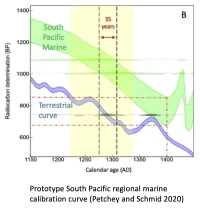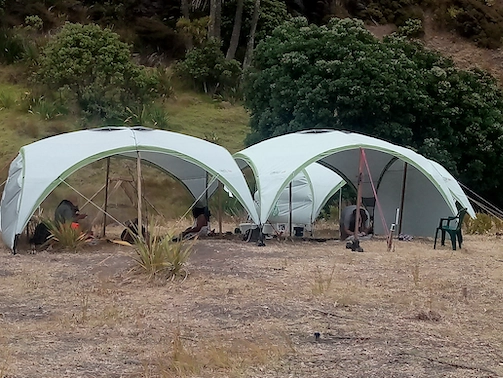
Prototype South Pacific regional marine calibration curve (Petchey and Schmid 2020)
Achieving this goal has, however, been elusive.
An initial project investigating marine 14C variability around New Zealand has given us the first temporal 14C marine model for the South Pacific (Petchey and Schmid 2020). This new knowledge is being applied to archaeological sites around Aotearoa, enabling us to explore critical questions about Māori settlement and cultural development afresh (Anderson and Petchey 2020).
Publications
Petchey, F., Dabell K., Clark G., & Parton P., (2023). Evidence of temporal changes in the marine 14C reservoir in the South Pacific and implications for improved dating resolution across a radiocarbon plateau (2600-2350 cal BP). Journal of Archaeological Science, doi:10.1016/j.jas.2023.105756.
Petchey, F., Bickler S., Hughes L., Bunbury, M, (2022). The Aotearoa/New Zealand Radiocarbon Database Upgrade. Archaeology in New Zealand, 65(3):32-40.
Bunbury, M.M.E., Petchey F., & Bickler S.H., (2022). A new chronology for the Māori settlement of Aotearoa (NZ) and the potential role of climate change in demographic developments. PNAS, 119(46), doi:10.1073/pnas.2207609119.
Anderson, A., & Petchey, F. (2020). The transfer of kumara (Ipomoea batatas) from east to south Polynesia and its dispersal in New Zealand. Journal of the Polynesian Society, 129(4):351-382.
Petchey, F., & Schmid, M.M.E. (2020). Vital evidence: Change in the marine 14C reservoir around New Zealand (Aotearoa) and implications for the timing of Polynesian settlement. Scientific Reports, 10(1):8 pages.
Related News
Motourua Island archaeological dig. RNZ, 18th Jan 2019
Mangahawea first human settlement. Te Ao Māori News, 18th Jan 2019

Mangahawea Bay excavation, Bay of Islands. Jan 2020 (Photo F. Petchey).
Acknowledgements
This research was supported by a Marsden Support grant from the University of Waikato. We wish to thank the Mangahawea Bay Partnership project (Patu Keha and Ngati Kuta, Department of Conservation, University of Otago, and Heritage New Zealand), Professor Atholl Anderson (ANU), Dr. Bruce McFadgen, Dr. James Robinson (Heritage New Zealand), Dr. Gerard O’Regan (Otago Museum) Dr. Louise Furey (Auckland War Memorial Museum), Dr. Magdalena Schmid (University of Kiel).